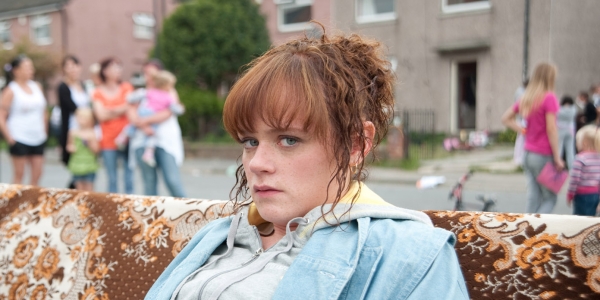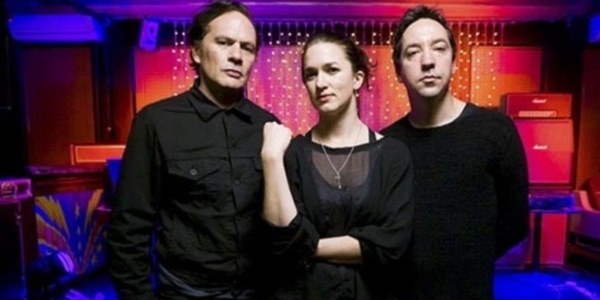She went on to produce two more works set in Buttershaw, Rita, Sue and Bob Too (1982) and Shirley (1986), the first of which was adapted into a now-cult British film directed by Alan Clarke (the script also written by Dunbar). Yet this brief brush with thespian fame did not alter life’s trajectory much at all for the disenfranchised playwright. Dunbar lived in the projects until her untimely death at age 29, retreating into alcoholism and eventually keeling over in her local pub from what was later revealed to be a brain aneurism.
Dunbar’s life is the subject of Clio Barnard’s award-winning new film, also titled The Arbor (2010), which will be screening at the Australian Centre for the Moving Image from September 1-4. What emerges here, however, is not only the details of a tragic life and wasted talent. The Arbor is also a story of intergenerational poverty – one that speaks as much about the ongoing class divisions that plague British society as it does about Dunbar and her descendants.
“In some ways, it’s a film about responsibility – individuals’ responsibility as well as collective responsibility – and I think that’s why it was important to tell this particular story,” says Barnard. “It’s a very complex and difficult set of circumstances… I hope it gives access to an understanding about three generations of a very socially, economically marginalised family”.
The Arbor is Barnard’s first feature, after a longstanding career in visual arts. Interestingly, she didn’t initially set out to make a film about Andrea Dunbar or her family. Like the playwright Robin Soans, who returned to Bradford in 2000 to create A State Affair, Barnard planned to provide a snapshot of life in the estates where Dunbar resided, examining how, if at all, conditions had changed in the 30 years since Dunbar’s original play was written.
But the story that emerged over the course of two years of interviews with Buttershaw locals, many of whom were Dunbar’s extended family, became too gripping to ignore. Barnard narrowed in on the relationship between Dunbar and her daughters Lorraine and Lisa, two women whose recollections of their mother were so disparate that “they could be talking about a different woman”. Lorraine remembers a mother who was neglectful, abusive and cold; Lisa remembers one simply did the best she could.
Employing the Verbatim Theatre techniques harnessed by Dunbar in her initial play (and also by Robin Soans) – a style of documentary theatre in which dialogue quotes interviewees – Barnard has devised a fresh and highly innovative approach to documentary filmmaking. Actors lip-synch over audio interviews, often shattering cinematic illusion by directly addressing the audience. These interviews are interspersed with segments of Dunbar’s play enacted on the streets of Buttershaw. Here Barnard explores a recurring interest that has also informed her artistic practice – documentary’s ambiguous relationship with so-called ‘reality’ and ‘fantasy’.
“It reminds the audience that documentaries are in some ways just as constructed as fiction films, and that they often have very similar narrative structures and narrative shapes,” she explains. “I suppose it’s to remind the audience that they’re watching the retelling of a true story, and that the truth is really quite an unstable thing”.
It is Lorraine’s story that ends up taking precedence, the tragic events of her life proving how futile her mother’s short-lived writerly fame was in combating the legacies of poverty. After Dunbar’s death, the then 11-year-old Lorraine was sent to live with her 18-year-old aunt. She was raped at age 14 and began using crack cocaine and heroin by 15, soon embarking upon on a career in street prostitution to feed her habit. The story of Lorraine’s two-year-old son Harris’ death after taking a dose of her methadone is truly harrowing.
Through the work of Dunbar, Soans and Barnard, we now have portraits of the Buttershaw estates over three decades and three generations. But if this most recent snapshot is any indication, things may have gotten worse rather than better. Considering recent events in Britain surrounding the youth riots, this examination of socio-economic disenfranchisement is more pertinent than ever. “I think in some ways we’re all responsible for what happened… in the UK,” says Barnard. “I think we’re responsible for a section of society being so marginalised and hidden”.
Despite the bleak aspects of this tale, however, Barnard found in Buttershaw a community who has retained warmth and kindness in the face of hardship – so much so that she’s just begun working on a second project with the estate’s residents. “The people I met are incredibly friendly, open, welcoming people,” says Dunbar. “I feel like I’ve got a lot of good friends up there now”.







